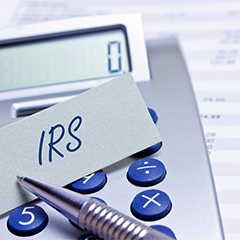IRS Raises Tangible Property Expensing Threshold
December 11, 2015 | Deductions, IRS Regulation, Tax Planning, Tax Preparation
 Many Maine businesses are uncertain how to account for costs to produce, acquire, or improve property, plant and equipment. To address this, in 2013 the IRS issued regulations on capitalizing versus deducting the costs of tangible personal property. In 2014, the IRS added rules covering dispositions of tangible property.
Many Maine businesses are uncertain how to account for costs to produce, acquire, or improve property, plant and equipment. To address this, in 2013 the IRS issued regulations on capitalizing versus deducting the costs of tangible personal property. In 2014, the IRS added rules covering dispositions of tangible property.
The IRS announced on November 24th that an increase in the de minimis safe harbor that will make it easier to deduct items like tablets and smartphones. This will give taxpayers the ability to immediately deduct many purchases that would otherwise need to be spread over a period of years through annual depreciation deductions. Here’s more on this potential tax savings opportunity.
Two Options for Reporting Fixed Assets
Businesses generally have two options when deciding how to handle tangible property costs::
Deduct now. IRS Section 162 allows you to deduct all ordinary and necessary expenses paid or incurred during the tax year in carrying on any trade or business, including the costs of certain supplies, repairs and maintenance.
Maine businesses can also deduct incidental repairs and routine building maintenance, including costs to inspect, clean, test and replace parts. In additional, they can deduct materials and supplies that cost $200 or less to acquire or produce under Section 162.
Capitalize and depreciate later. Section 263 requires you to capitalize amounts paid to acquire, produce or improve tangible property. Capitalized costs are generally not deducted in the current tax year; they’re depreciated over their economic useful lives.
Under Section 263, however, you must generally capitalize improvements that:
- Add to the value, or substantially prolong the useful life, of your property, or
- Adapt the property to a new or different use.
The decision to capitalize or expense an item is just a matter of timing. Regardless of how you classify the costs, you will pay the same taxes over the life of the asset, as long as laws and tax rates remain consistent. If you expect higher tax rates or more restrictive tax laws in the future, you might prefer to capitalize costs to reduce taxable income in future periods.
Some items are easily classified as a deductible business expense (such as a box of copy paper) or a capital expenditure (such as a new forklift). However, some items fall in the gray area between Sections 162 and 263. The final repairs refine and clarify those gray areas, as well as provide various de minimis “safe harbors.”
Safe Harbor for Companies with Audited Financial Statements
The final regulations permit businesses to elect to expense their outlays for “de minimis” business expenses as an alternative to the general capitalization rule. The IRS permits certain taxpayers to deduct tangible property they acquire or produce, if the total cost per item (or invoice) is $5,000 or less. In order to qualify for this safe harbor, you must:
- Possess a written accounting procedure at the beginning of the tax year for expensing property under a specified dollar amount.
- Prepare an “applicable financial statement.” That is, a certified audited financial statement or a financial statement filed with a state or local government.
- Expense the cost on your applicable financial statement, not just your tax return.
The de minimis safe harbor also applies to property with an economic useful life of 12 months or less as long as the item doesn’t cost more than $5,000 per item (or per invoice).
Updated Safe Harbor
Taxpayers without applicable (audited) financial statements, however, will be subject to a new $2,500 capitalization threshold (up from $500). Tangible property costs below this amount are generally considered to be ordinary and necessary business expenses and, therefore, not treated as capital expenditures under the final repair regulations.
“We received many thoughtful comments from taxpayers, their representatives and the professional tax community. This important step simplifies taxes for small businesses, easing the recordkeeping and paperwork burden on small business owners and their tax preparers,” said IRS Commissioner John Koskinen.
Since February, the IRS received more than 150 letters from businesses and their representatives requesting an increase in the threshold. They received multiple comments noting that the cost of many commonly expensed items, such as smartphones, tablet-style personal computers, and machinery and equipment parts, surpass the $500 threshold.
Just as before, taxpayers can still claim otherwise deductible repair and maintenance costs, even if they exceed the $2,500 threshold. Also, if the taxpayer can demonstrate that a higher threshold clearly reflects the taxpayer’s income, the existence of the de minimis safe harbor doesn’t mean that a taxpayer cannot establish a de minimis deduction threshold in excess of the safe harbor amount.
The new $2,500 threshold takes effect starting with tax year 2016. In addition, the IRS will provide audit protection to eligible taxpayers by not challenging use of the new $2,500 threshold in tax years prior to 2016.
Updating Your Capitalization Policies
In regards to IRS Notice 2015-82, it’s now easier for qualifying taxpayers to deduct tangible personal property costs under the de minimis safe harbor. Update your tangible property capitalization policies for the increased safe harbor threshold before filing your 2015 federal tax review. Doing so could result in potential tax savings opportunities.
This article barely scratches the surface of this complex topic. Contact Filler & Associates, or your tax adviser, for more information. We can help your Maine business evaluate the decision to deduct or capitalize tangible property costs and ensure compliance with the latest IRS regulations and procedures.
